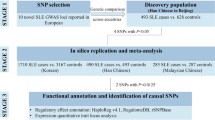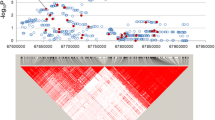Abstract
The IRF5 gene was found to be strongly associated with SLE. We identified two functional polymorphisms and recently an insertion/deletion together with a tag SNP defining the risk haplotype in individuals of European ancestry. We now analyzed sets of Mexican patients with SLE. Three polymorphisms in the IRF5 gene were genotyped in two sets of Mexican individuals with SLE and controls as well as in families including a set of pediatric SLE patients. A set of healthy Mexican Indians was also typed. Genetic association with SLE was found for all three polymorphisms. The genetic association was very strong in the case–control analysis in both sets (for SNP rs2070197, combined P = 1.26 × 10−21) and in families (combined P = 0.000004). Compared to healthy individuals with European ancestry, the frequency of the risk haplotype in healthy Mexican individuals was significantly higher and even higher in the healthy Mexican Indian group. Further, a much higher frequency of the risk haplotype and of individual homozygote for it was found among Mexican SLE patients. The significantly higher frequency of homozygote individuals for the risk haplotype among Mexican SLE patients could be the result of genetic admixture, and suggests the possibility that IRF5 could be involved in the more active disease and organ involvement known to occur among Mexican SLE patients.
Similar content being viewed by others
References
Alarcon GS, McGwin G Jr, Roseman JM et al (2004) Systemic lupus erythematosus in three ethnic groups. XIX. Natural history of the accrual of the American College of Rheumatology criteria prior to the occurrence of criteria diagnosis. Arthritis Rheum 51:609–615
Alarcon GS, Bastian HM, Beasley TM et al (2006) Systemic lupus erythematosus in a multi-ethnic cohort (LUMINA) XXXII: [corrected] contributions of admixture and socioeconomic status to renal involvement. Lupus 15:26–31
Andrade RM, McGwin G Jr, Alarcon GS et al (2006) Predictors of post-partum damage accrual in systemic lupus erythematosus: data from LUMINA, a multiethnic US cohort (XXXVIII). Rheumatology (Oxford) 45:1380–1384
Baechler EC, Batliwalla FM, Karypis G et al 2003 Interferon-inducible gene expression signature in peripheral blood cells of patients with severe lupus. Proc Natl Acad Sci USA 100:2610–2615
Barnes BJ, Moore PA, Pitha PM (2001) Virus-specific activation of a novel interferon regulatory factor, IRF-5, results in the induction of distinct interferon alpha genes. J Biol Chem 276:23382–23390
Barnes BJ, Kellum MJ, Field AE et al (2002) Multiple regulatory domains of IRF-5 control activation, cellular localization, and induction of chemokines that mediate recruitment of T lymphocytes. Mol Cell Biol 22:5721–5740
Barnes B, Lubyova B, Pitha PM (2002) On the role of IRF in host defense. J Interferon Cytokine Res 22:59–71
Bennett L, Palucka AK, Arce E et al (2003) Interferon and granulopoiesis signatures in systemic lupus erythematosus blood. J Exp Med 197:711–723
Calvo-Alen J, Reveille JD, Rodriguez-Valverde V et al (2003) Clinical, immunogenetic and outcome features of Hispanic systemic lupus erythematosus patients of different ethnic ancestry. Lupus 12:377–385
Cunha BA (2004) Smallpox and measles: historical aspects and clinical differentiation. Infect Dis Clin North Am 18:79–100
Fenner F (1980) The global eradication of smallpox. Med J Aust, vol 1, pp 455–5
Graham RR, Ortmann WA, Langefeld CD et al (2002) Visualizing human leukocyte antigen class II risk haplotypes in human systemic lupus erythematosus. Am J Hum Genet 71:543–553
Graham DS, Manku H, Wagner S et al (2006) Association of IRF5 in UK SLE families identifies a variant involved in Polyadenylation. Hum Mol Genet
Graham RR, Kozyrev SV, Baechler EC et al (2006) A common haplotype of interferon regulatory factor 5 (IRF5) regulates splicing and expression and is associated with increased risk of systemic lupus erythematosus. Nat Genet 38:550–555
Granados J, Vargas-Alarcon G, Andrade F et al (1996) The role of HLA-DR alleles and complotypes through the ethnic barrier in systemic lupus erythematosus in Mexicans. Lupus 5:184–189
Klein-Gitelman M, Reiff A, Silverman ED (2002) Systemic lupus erythematosus in childhood. Rheum Dis Clin North Am 28:561–577
Kozyrev SV, Lewén S, Linga Reddy MVP, Pons-Estel BA, The Argentine colloborative group, Witte T, The German colloborative group, Junker P, Laustrup H, Gutiérrez C, Suárez A, González-Escribano MF, Martín J, The Spanish colloborative group and Alarcón-Riquelme ME (2007). Structural insertion/deletion variation in IRF5 is associated with a risk haplotype and defines the precise isoforms expressed in SLE. Arthritis Rheum 56:1234-1241
Patterson KB, Runge T (2002) Smallpox and the Native American. Am J Med Sci 323:216–222
Pons-Estel BA, Catoggio LJ, Cardiel MH et al (2004) The GLADEL multinational Latin American prospective inception cohort of 1,214 patients with systemic lupus erythematosus: ethnic and disease heterogeneity among “Hispanics”. Medicine (Baltimore) 83:1–17
Ronnblom LE, Alm GV, Oberg KE (1990) Possible induction of systemic lupus erythematosus by interferon-alpha treatment in a patient with a malignant carcinoid tumour. J Intern Med 227:207–210
Schoenemeyer A, Barnes BJ, Mancl ME et al (2005) The interferon regulatory factor, IRF5, is a central mediator of toll-like receptor 7 signaling. J Biol Chem 280:17005–17012
Sigurdsson S, Nordmark G, Goring HH et al (2005) Polymorphisms in the Tyrosine Kinase 2 and interferon regulatory factor 5 genes are associated with systemic lupus erythematosus. Am J Hum Genet 76(3):528–537
Takaoka A, Yanai H, Kondo S et al (2005) Integral role of IRF-5 in the gene induction programme activated by Toll-like receptors. Nature 434:243–249
Vila LM, Alarcon GS, McGwin G Jr et al (2004) Early clinical manifestations, disease activity and damage of systemic lupus erythematosus among two distinct US Hispanic subpopulations. Rheumatology (Oxford) 43:358–363
Yanai H, Chen HM, Inuzuka T, Kondo S, Mak TW, Takaoka A, Honda K, Taniguchi T (2007) Role of IFN regulatory factor 5 transcription factor in antiviral immunity and tumor suppression. Proc Natl Acad Sci USA 104:3402–3407
Yang N, Li H, Criswell LA et al (2005) Examination of ancestry and ethnic affiliation using highly informative diallelic DNA markers: application to diverse and admixed populations and implications for clinical epidemiology and forensic medicine. Hum Genet, pp 1–11
Acknowledgments
This work has been supported by the Swedish Research Council, the Torsten and Ragnar Söderbergs Stiftelse, the Marcus Borgströms Foundation, the Gustav V:e-80-års Foundation, the Magnus Bergwalls Foundation, and the Swedish Association against Rheumatism to MEAR. MEAR is supported by a grant from the Knut and Alice Wallenberg Foundation awarded through the Royal Swedish Academy of Sciences. This study was also supported in part by the Consejo Nacional de Ciencia y Tecnología (CONACYT: SALUD-2004-01-153) from Mexico City, Mexico.
Author information
Authors and Affiliations
Corresponding author
Additional information
M. V. Prasad Linga Reddy and Rafael Velázquez-Cruz contributed equally to this work.
Rights and permissions
About this article
Cite this article
Reddy, M.V.P.L., Velázquez-Cruz, R., Baca, V. et al. Genetic association of IRF5 with SLE in Mexicans: higher frequency of the risk haplotype and its homozygozity than Europeans. Hum Genet 121, 721–727 (2007). https://doi.org/10.1007/s00439-007-0367-6
Received:
Accepted:
Published:
Issue Date:
DOI: https://doi.org/10.1007/s00439-007-0367-6




